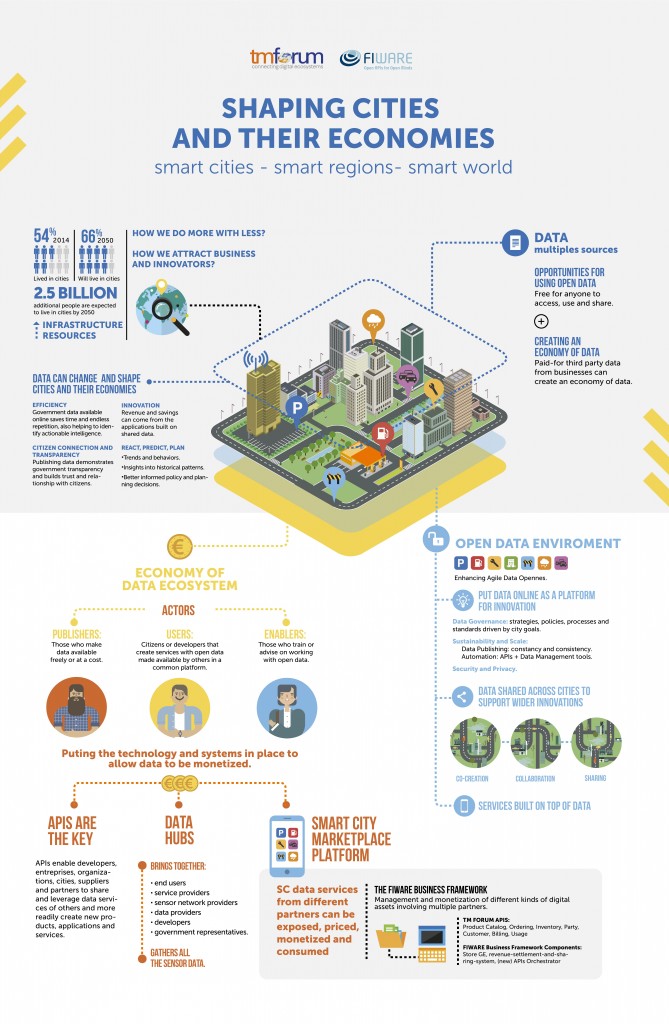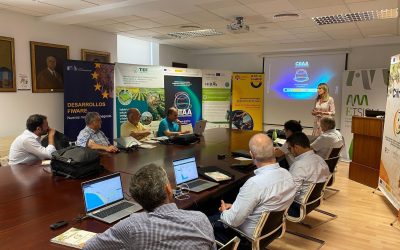In tech and business circles, adding the word “economy” to anything is a bit like adding the word “artisanal” to a product description. It sounds impressive, but what does it actually mean? What do we mean when we say data economy? Is there a data economy now? What are the implications for industry? Cities? Citizens?
The “data economy” relates to all the building bricks and businesses that compose the whole value chain from the creation of data to the end user’s data usage, and the value that is created and shared (often measured in terms of money) along the way.
We have recently looked at how platform business models are changing the business landscape. In this emerging worldview, value is co-created by a business in collaboration with partners and even end-users. Businesses decreasingly create final products and services to be consumed as they were made, and instead a business opens up the components that make up a product or service. Partners or end users mix those components together and add external components from other sources, to create the product they need.
FIWARE’s infrastructure components, including the NGSI API and many of its generic enablers, are a good example of this platform model and its component approach. Startups and enterprises are able to use FIWARE components — like data storage, compute processing, realtime data feeds, big data analytics, and other services — in the order needed to create a new generation of applications and digital technologies.
As this infrastructure is taken up by industries as diverse as agriculture, manufacturing, transport and logistics, utilities and energy, and city management, it becomes clear how complex our social and industrial ecosystems are, making things like smart city initiatives difficult to implement.
With so many stakeholders involved, a smart city system connecting all elements must be able to collect the data and services needed at the right time to create value for citizens, communicate effectively with various actors and attribute resource usage and costs along a usage path.
Where this sort of system works effectively, it is called a dynamic value chain.
The inability for a smart city system to do this effectively inhibits innovation and prevents startups and smaller providers from participating, as they are unable to ensure that their contribution will be recognized in such a large and complex system of interconnections. This can have an impact on equality of opportunity and local economic development, as newer businesses find it difficult to participate and earn their share from the contribution they provide.
So a smart city dynamic value chain needs to be a platform that can:
-
Identify and collate data and services from multiple suppliers
-
Compose them in the right order
-
Expose them to end users when needed; and
-
Share the revenue accordingly from the value created through the system.
In some cases, this could mean end users paying for an app and then using a particular data set. In other examples, it could mean data or services that help city authorities or businesses to reduce costs or create efficiencies (which is an even more complex revenue sharing model to define in a smart city ecosystem).
It is not just smart cities that are struggling with how to create the infrastructure and participatory model that enables a dynamic value chain. It is becoming increasingly common amongst platform business models that rely on external data providers to contribute value to their ecosystem.
There is a platform called Blockspring, for example, that helps end users to create simple spreadsheets using APIs. Users can build spreadsheets that automatically add in data from APIs, so end users do not need programming skills to gain value from an API. Blockspring charges users to access the platform, and it is kind-of an economic multiplier for the API providers included in the Blockspring catalog. They don’t share revenue with these data providers directly, but Blockspring end users who want to make use of the spreadsheet tools will need to sign up with the API providers and pay for the API usage when data is pulled in to their spreadsheets. It is a simple way to get around what could be a more complex model, but leaves several ecosystem partners outside of this economy. For example, what if someone is very good at making spreadsheet tools and wants to monetize the templates they create using Blockspring? There is no marketplace for these stakeholders (enablers) at present.
Algorithmia is another platform with a programmable business model. They offer a marketplace for machine learning algorithms that can be added to a larger process by API. They have a more sophisticated revenue sharing model, where developers who create predictive and other machine learning algorithms can share them on the platform. When end users make use of an algorithm, the developer gets paid a share of revenue whenever the algorithm carries out a processing task. The platform also offers a way for businesses to ask for specific machine learning algorithms and can set prices for what they need so developers with expertise can share their knowledge.
Again, this is an emerging marketplace, so not everyone is incentivized to participate in this economy. If an end user wants to take the algorithm and use it in their internal business processes, Algorithmia needs to connect the developer and end user manually, rather than enabling any automated system. This can reduce the opportunity to scale solutions effectively. Imagine if a city’s bike rental scheme wanted to use an algorithm that calculated how to most efficiently restock empty bike racks. A startup that was offering this type of machine learning algorithm might end up facing an overwhelming number of private requests to run that algorithm at individual cities, which would limit the startup’s ability to scale effectively to meet demand. At present, the Algorithmia service is also focused on sharing machine learning tools. But what about large datasets that you could apply those tools to? There is no marketplace as such yet, for data providers to earn revenue in this ecosystem by sharing their data for other machine learning uses.
Blockspring and Algorithmia are exciting examples of what is possible by focusing on how to foster a data economy. Meanwhile, community members are calling out for other service providers to follow this leadership. A tweet last week from @hichaelmart asked:
“Soooo, when's AWS gonna build a Lambda Marketplace? ie an AMI marketplace equivalent, where lambda authors earn X% every time it's invoked?”
This is exactly the sort of question that will become more prominent in a data economy for the Internet of Things and smart cities.
This year, FIWARE and TM Forum have been working in collaboration to foster the data economy, where everyone can contribute by opening up their data, building applications, or providing services.
An economy of data ecosystem acknowledges various actors and values their contributions. This can include:
-
Publishers: Data providers who share their data for free or for a fee. This could be an exciting equity opportunity for individual citizens as well. Imagine a future where you received some credits for contributing data and insights to a crowd-sourced data sharing platform.
Already, a lot of personal data is collected by third parties, whether that be health data through wearables, social media insights, or transport usage data. Imagine a future where citizens can opt-in to share that data with others in an anoymized form. The individual is empowered to own their personal data and can sell it back to other actors in the data economy. Perhaps for doing so, they receive a financial “dividend”, although we imagine this dividend would be quite small for an individual’s data contribution, but perhaps instead, the user could receive some additional free access to the product, or a more personalized set of features from a service provider because they are sharing their data. A data economy that can measure the value generated in a dynamic value chain can better attribute that value to the various actors within the system.
-
Users: Developers, citizens and community groups can better create services and tools with open data. A thriving data economy that can recognize individual contributions is a self-fulfilling and knowledge generating ecosystem. By being able to recognize and better value contributions, a data economy encourages participation and active learning.
-
Enablers: Open data and tools like FIWARE’s NGSI API still require a certain level of skill. A bit like how Blockspring users can create spreadsheets that make APIs accessible to non-programmers, there will be a need for service providers and professionals who are able to train, build templates for others, and advise on the rich opportunities available for using open data. Some of these enablers will be subject knowledge experts who are able to help users discover what datasets are even available, while others may be able to create templates that add a valuable perspective, such as the ability to add an equity lens that measures the equality-generating opportunities (or inequality widening risks) of a smart city initiative.
The following infographic ilustrates how the partnership between TM Forum and FIWARE is
enabling an economy of data in the smart cities. Click on the image to see it full size:
 With the FIWARE and TM Forum collaboration, FIWARE has built a composable infrastructure of tools such as the NGSI API which enables realtime data sharing collected from IoT devices, open datasets, sensors, and other sources. TM Forum has created a fabric of business system APIs that enable participation in this emerging data economy.
With the FIWARE and TM Forum collaboration, FIWARE has built a composable infrastructure of tools such as the NGSI API which enables realtime data sharing collected from IoT devices, open datasets, sensors, and other sources. TM Forum has created a fabric of business system APIs that enable participation in this emerging data economy.
Data providers can use FIWARE’s NGSI API to make their data available to others. The TM Forum APIs then help onboard those data providers to be recognized in the ecosystem, and to share their data with application developers, cities, and other businesses. Their suite of business APIs can then track when that data is requested to be used by other actors, create agreements between the parties, calculate revenue to be shared, and make payments whenever that data is used. Thanks to our collaboration, this is a “smart contract” model where the whole complex web of interactions in this workflow are automated.
Next week, FIWARE will be participating in TM Forum Live in Nice, France, where we will be hearing from cities around the world who already have a need for the infrastucture and fabric of a data economy in order to make their smart city systems more inclusive, economically viable, and participatory. We are excited to see the potential that can be realized now that a data economy is truly possible.



